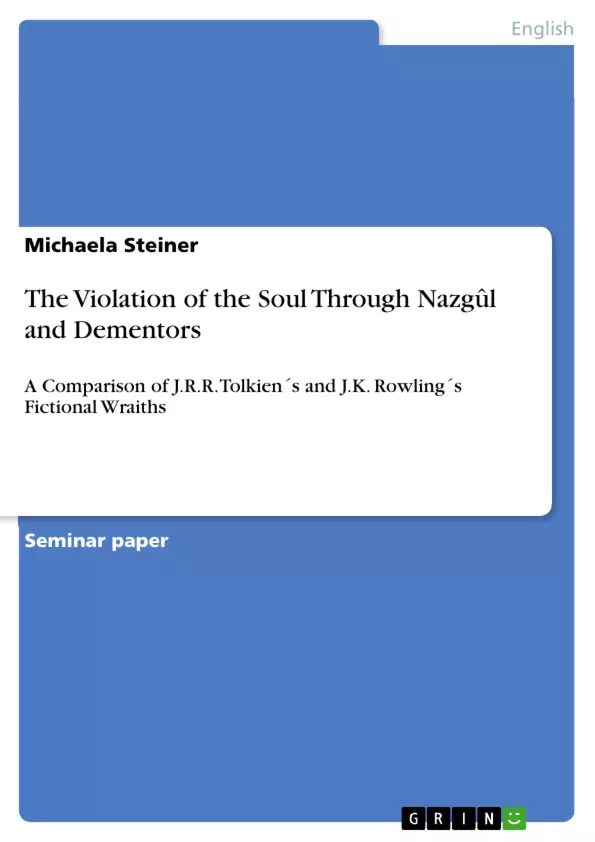Although there has been written a lot of investigative literature about the works of both J.R.R. Tolkien and J.K. Rowling, the research topic of this paper is still widely unexplored. Comparing the concepts of Tolkien´s Nazgûl and Rowling´s Dementors suggests itself since – besides their physical appearance - they offer distinct parallels but also, considering the background of their stories, are very different from each other. The analysis of this paper is supposed to determine the consequences fictional characters experience from encounters with those ghost-like creatures; the thesis underlying the analysis is that both Nazgûl and Dementors violate their victims in harming and/or destroying their souls.
Table of Contents
- Soul-Suckers and Ringwraiths: Assaulting Ghost Creatures
- Victims, Reasons and Methods
- Doomed Convicts, Prey and Ring-Thieves
- Hunger and Desire, Malice and Obedience
- Abulia, Dark Breath, Death and Total Destruction
- Soul-Suckers Destroy, Ringwraiths Harm
Objectives and Key Themes
This paper compares the fictional creatures Nazgûl (from Tolkien's works) and Dementors (from Rowling's works), focusing on how they impact their victims. The analysis aims to determine the consequences characters face when encountering these beings, specifically whether their actions constitute a violation and destruction of the soul. The paper explores similarities and differences in their methods, motivations, and effects.
- Comparison of the methods used by Nazgûl and Dementors to attack their victims.
- Analysis of the motivations behind the attacks by both types of creatures.
- Examination of the consequences suffered by victims, focusing on the concept of soul-violation.
- Exploration of the similarities and differences between the two types of creatures.
- Definition and application of the concept of the "soul" within the context of the fictional worlds.
Chapter Summaries
1. Soul-Suckers and Ringwraiths: Assaulting Ghost Creatures: This introductory chapter establishes the paper's central argument: that both Nazgûl and Dementors violate their victims by harming or destroying their souls. It introduces the core research question and outlines the structure of the analysis. The chapter also presents a working definition of the soul, acknowledging its abstract nature and extending the definition beyond purely human terms to encompass the non-human characters affected by these creatures in the respective fictional universes. The chapter sets the stage for a comparative analysis of Tolkien's and Rowling's creations, highlighting the unexplored nature of this specific comparative study despite existing scholarship on their individual works.
2. Victims, Reasons and Methods: This chapter delves into a detailed comparison of the victims, reasons for attack, and methods employed by Dementors and Nazgûl. For Dementors, the analysis focuses on their indiscriminate targeting of individuals, driven primarily by a need for sustenance—absorbing positive emotions and memories. The chapter connects this with Rowling's portrayal of despair and its link to criminality and madness. The Dementors' role as prison guards in Azkaban is examined as a form of cruel and effective punishment, highlighting the fear they inspire within the wizarding world and deterring criminal acts. In contrast, the Nazgûl’s attacks are more targeted, focusing on those who hinder their quest for the One Ring. The chapter examines their role in Sauron's broader scheme, as both pursuers of the Ring and agents of fear and intimidation. Examples from the texts illustrate the differing approaches, emphasizing the intentional targeting of those who possess or threaten the Ring for the Nazgûl, versus the indiscriminate nature of the Dementors' feeding.
Keywords
Nazgûl, Dementors, J.R.R. Tolkien, J.K. Rowling, soul, violation, fantasy literature, comparative analysis, fear, despair, power, destruction, Ring, Harry Potter, Lord of the Rings.
Frequently Asked Questions: A Comparative Analysis of Nazgûl and Dementors
What is the main topic of this paper?
This paper compares the fictional creatures Nazgûl (from Tolkien's works) and Dementors (from Rowling's works), focusing on how they impact their victims and whether their actions constitute a violation and destruction of the soul. It analyzes their methods, motivations, and effects, exploring similarities and differences.
What are the key themes explored in the paper?
Key themes include a comparative analysis of the methods used by Nazgûl and Dementors to attack their victims; an examination of the motivations behind these attacks; an exploration of the consequences suffered by victims, focusing on soul-violation; a comparison of the similarities and differences between the two types of creatures; and a definition and application of the concept of the "soul" within the context of the fictional worlds.
What are the chapters and their summaries?
Chapter 1: Soul-Suckers and Ringwraiths: Assaulting Ghost Creatures introduces the central argument that both Nazgûl and Dementors violate victims' souls, outlines the research question and structure, and presents a working definition of the "soul". Chapter 2: Victims, Reasons and Methods compares the victims, reasons for attack, and methods employed by Dementors and Nazgûl, detailing the Dementors' indiscriminate targeting and the Nazgûl's more targeted attacks.
What are the objectives of this research?
The objectives are to compare the methods of attack, analyze the motivations, examine the consequences for victims (particularly soul-violation), explore similarities and differences between the creatures, and define and apply the concept of the "soul" within the fictional contexts.
What are the key words associated with this research?
Key words include Nazgûl, Dementors, J.R.R. Tolkien, J.K. Rowling, soul, violation, fantasy literature, comparative analysis, fear, despair, power, destruction, Ring, Harry Potter, and Lord of the Rings.
What is the structure of the provided text?
The text provides a comprehensive language preview, including a table of contents, objectives and key themes, chapter summaries, and keywords. It acts as an overview of a larger academic paper.
What kind of audience is this preview intended for?
This preview is intended for an academic audience, providing a structured and professional overview of the research to facilitate understanding of the paper's scope and methodology.
- Arbeit zitieren
- Michaela Steiner (Autor:in), 2011, The Violation of the Soul Through Nazgûl and Dementors, München, GRIN Verlag, https://www.grin.com/document/183563




